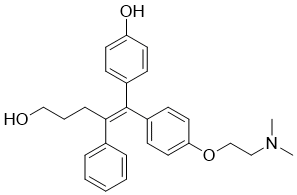| Cas No.: | 877387-37-6 |
| Chemical Name: | GSK5182 |
| Synonyms: | GSK5182; GSK 5182; GSK-5182. |
| SMILES: | OC1=CC=C(/C(C2=CC=C(OCCN(C)C)C=C2)=C(C3=CC=CC=C3)\CCCO)C=C1 |
| Formula: | C27H31NO3 |
| M.Wt: | 417.54 |
| Purity: | >98% |
| Sotrage: | 0°C (short term), -20°C (long term), desiccated |
| Description: | GSK5182 is a highly selective inverse agonist of estrogen-related receptor γ (ERRγ) with an IC50 of 79 nM and does not interact with other nuclear receptors, including ERRα or ERα, due to its additional non-covalent interactions with Y326 and N346 at the active site of ERRγ. GSK5182 also induces Reactive Oxyen Species (ROS) generation in hepatocellular carcinoma (HCC)[1][2][3]. |
| Target: | ERRγ:79 nM (IC50) |
| In Vivo: | GSK5182 (40 mg/kg; intraperitoneal injection; every day; 25 or 30 days; db/db mice, diet-induced obesity mice) specifically inhibits the transcriptional activity of ERRγ, and suppresses hepatic glucose production through inhibition of hepatic gluconeogenesis. GSK5182 elicits anti-diabetic effects in mouse models via negative regulation of the hepatic gluconeogenesis program. GSK5182 normalizes hyperglycemia mainly through inhibition of hepatic glucose production[3]. Animal Model: db/db mice (male, 7-12-week-old), diet-induced obesity (DIO) mice[3] Dosage: 40 mg/kg Administration: Intraperitoneal injection; every day; 30 days for db/db mice, 25 days for DIO mice Result: Inhibited the transcriptional activity of ERRγ, suppressed hepatic glucose production through inhibition of hepatic gluconeogenesis. |
| In Vitro: | GSK5182 (0-20 μM; 0-hours; PLC/PRF/5 cells) treatment leads to a significant and dose-dependent reduction in the number of proliferating PLC/PRF/5 cells[1]. GSK5182 (0-20 μM; 24 hours; PLC/PRF/5 cells) treatment also causes a dose-dependent increase in the expression of p21 and p27 while at the same time reducing the level of phosphorylated retinoblastoma protein (p-pRb)[1]. GSK5182 (10-20 μM; PLC/PRF/5 cells) treatment induces cell cycle arrest at G1 phase, which in turn induces a corresponding dose-dependent reduction in the percentage of cells in S phase[1]. Cell Proliferation Assay[1] Cell Line: The human hepatoma cell line PLC/PRF/5 Concentration: 0 μM, 10 μM, 20 μM Incubation Time: 0 hour, 24 hours, 48 hours, 72 hours Result: Led to a significant and dose-dependent reduction in the number of proliferating PLC/PRF/5 cells. Western Blot Analysis[1] Cell Line: The human hepatoma cell line PLC/PRF/5 Concentration: 0 μM, 10 μM, 20 μM Incubation Time: 24 hours Result: Caused a dose-dependent increase in the expression of p21 and p27 while at the same time reducing the level of p-pRb. Cell Cycle Analysis[1] Cell Line: The human hepatoma cell line PLC/PRF/5 Concentration: 10 μM, 20 μM Incubation Time: Result: Induced cell cycle arrest. |
| References: | [1]. Kim JH, et al. Estrogen-related receptor γ is upregulated in liver cancer and its inhibition suppresses livercancer cell proliferation via induction of p21 and p27. Exp Mol Med. 2016 Mar 4;48:e213. [2]. Misra J, et al. ERRγ: a Junior Orphan with a Senior Role in Metabolism. Trends Endocrinol Metab. 2017 Apr;28(4):261-272. [3]. Kim DK, et al. Inverse agonist of nuclear receptor ERRγ mediates antidiabetic effect through inhibition of hepatic gluconeogenesis. Diabetes. 2013 Sep;62(9):3093-102. |

 To enhance service speed and avoid tariff delays, we've opened a US warehouse. All US orders ship directly from our US facility.
To enhance service speed and avoid tariff delays, we've opened a US warehouse. All US orders ship directly from our US facility.




















